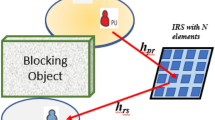Abstract
The transmission capacities (TC) is defined as the sum of successful transmissions per unit area in the secondary and the primary systems while meeting the target outage probabilities of both. We obtain the TC of different spectrum sharing modes in cognitive radio networks over fading channels by stochastic geometry. The ratios of transmission power and user density between two systems are derived. The constraint is found to make the TC of spectrum sharing mode exceed that of single system mode. The upper bound of TC is derived and an accessing strategy to reach the maximum value is proposed, under which the TC of secondary user will be maximized when that of primary user is fixed. Numerical results confirm the analytical derivations and show that the TC with our accessing strategy will be larger than that of single primary system mode or fixed spectrum sharing mode.





Similar content being viewed by others
References
Federal Communications Commission. (2002). Spectrum Policy Task Force, Rep. ET 2002, Docket no. 02-135.
Xie, S., Liu, Y., Zhang, Y., & Yu, R. (2010). A parallel cooperative spectrum sensing in cognitive radio networks. IEEE Transaction on Vehicular Technology, 55(8), 4079–4092.
Bastami, Babak Abbasi, & Saberinia, Ebrahim. (2013). A practical multibit data combining strategy for cooperative spectrum sensing. IEEE Transaction on Vehicular Technology, 62(1), 384–389.
Zhi, Q., Shuguang, C., & Ali, H. S. (2008). Optimal linear cooperation for spectrum sensing in cognitive radio networks. IEEE Journal of Selected Topics in Signal Processing, 2(1), 28–40.
Zhang, Z., Han, Z., Li, H., Yang, D., & Pei, C. (2011). Belief propagation based cooperative compressed spectrum sensing in wideband cognitive radio networks. IEEE Transaction on Wireless Communications, 10(9), 3020–3031.
Zhang, Y. L., Zhang, Q. Y., & Melodia, T. (2010). A frequency-domain entropy-based detector for robust spectrum sensing in cognitive radio networks. IEEE Communications Letters, 14(6), 533–535.
Zhang, S., & Bao, Z. (2011). An adaptive spectrum sensing algorithm under noise uncertainty. In Proceedings of IEEE international conference on communications (ICC), Kyoto, Japan (pp. 1–5).
Shen, L., Wang, H., Zhang, W., & Zhao, Z. (2011). Blind spectrum sensing for cognitive radio channels with noise uncertainty. IEEE Transactions on Wireless Communications, 10(6), 1721–1724.
Shen, J., Jiang, T., Liu, S., & Zhang, Z. (2009). Maximum channel throughput via cooperative spectrum sensing in cognitive radio networks. IEEE Transactions on Wireless Communications, 8(10), 5166–5175.
Stergios, S., & Arumugam, N. (2012). On the throughput and spectrum sensing enhancement of opportunistic spectrum access cognitive radio networks. IEEE Transactions on Wireless Communications, 11(1), 97–107.
Yin, W., Ren, P., Du, Q., & Wang, Y. (2012). Delay and throughput oriented continuous spectrum sensing schemes in cognitive radio networks. IEEE Transactions on Wireless Communications, 11(6), 2148–2159.
Vartiainen, J., Hoyhtya, M., Lehtomaki, J., & Braysy, T. (2010). Priority channel selection based on detection history database. In Proceedings of the 5th CrownCom (pp. 1–5).
Do, T., & Mark, B. L. (2010). Joint user–temporal spectrum sensing for cognitive radio networks. IEEE Transactions on Vehicular Technology, 59(7), 3480–3490.
Gupta, P., & Kumar, P. R. (2000). The capacity of wireless networks’. IEEE Transactions on Information Theory, 46(2), 388–404.
Jemin, L., Sungmook, L., Jeffrey, G. A., & Daesik H. (2010) Achievable transmission capacity of secondary system in cognitive radio networks. In Proceedings of IEEE International Conference on Communications (ICC), Capetown, South Africa (pp. 1–5).
Mohammad, G. K., Keivan, N., & Halim, Y. (2010) Impact of the secondary network on the outage performance of the primary service in spectrum sharing. In Proceedings of IEEE International Conference on Communications (ICC), Capetown, South Africa (pp. 1–5).
Changchuan, Y., Long, G., Tie, L., & Shuguang, C. (2009). Transmission capacities for overlaid wireless ad hoc networks with outage constraints. In Proceedings of IEEE International Conference on Communications (ICC), Dresden, Germany (pp. 1–5).
Lee, J., Andrews, J. G., & Hong, D. (2011). Spectrum-sharing transmission capacity. IEEE Transactions on Wireless Communications, 10(9), 3053–3063.
Stoyan, D., Kendall, W., & Mecke, J. (1996) Stochastic geometry and its applications (2nd ed.). Ney York: Wiley, 2008.
Kingman, J. F. C. (1993). Poisson processes (1st ed.). Oxford: Oxford University Press.
Acknowledgements
The authors would like to thank the reviewers for their detailed reviews and constructive comments, which have helped improve the quality of this paper. This work was supported in part by the important national science and technology specific projects under Grant No. 2011ZX03005-004-03, National Natural Science Foundation of China under Grant No. 61171081, National Natural Science Foundation of China under Grant No. 61362038, Natural Science Foundation of Guangxi under Grant No. 2011GXNSFB018075, and important project of Wuzhou university under Grant No. 2013B002.
Author information
Authors and Affiliations
Corresponding author
Rights and permissions
About this article
Cite this article
Xie, S., Shen, L. Maximum Transmission Capacity in Cognitive Radio Networks. Wireless Pers Commun 96, 3193–3206 (2017). https://doi.org/10.1007/s11277-017-4348-3
Published:
Issue Date:
DOI: https://doi.org/10.1007/s11277-017-4348-3




